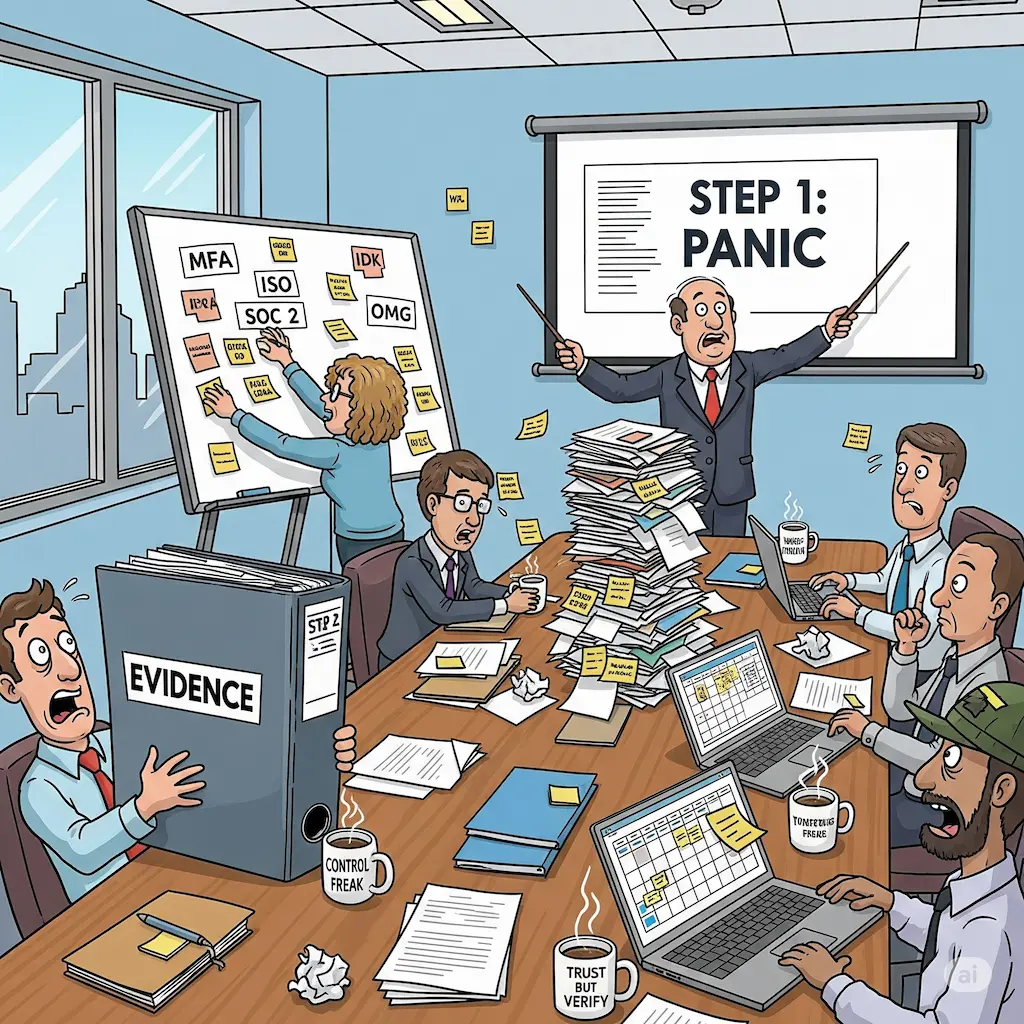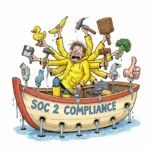Whether it’s your first SOC 2 audit or you’ve been through it a few times, one thing’s for sure—being prepared makes all the difference. The common question when preparing for an audit gets asked, “How can we make sure the audit goes smoothly?” The truth is, it comes down to planning ahead and knowing what to expect.

A good readiness assessment gives you a clear picture of what’s working and what’s not. It helps you get ahead of issues and makes the audit feel more like a planned project than a surprise check-in.
That’s where a SOC 2 readiness assessment comes in. Think of it as a dress rehearsal before the real audit. It gives you a chance to see where you stand, spot any gaps, and fix what needs fixing before auditors come in. In this post, we’ll break down what a readiness assessment looks like and how to tackle it step by step.
What’s a SOC 2 Readiness Assessment?
As the name implies, a SOC 2 readiness assessment evaluates whether your organization is ready for a formal SOC 2 audit. Your organization has it’s own defined processes, well these processes get written into internal controls and aligned to meet the Trust Services Criteria (TSC): Security, Availability, Processing Integrity, Confidentiality, and Privacy items that you are choosing (one or more from the list).
You can perform this internally or with the help of a qualified CPA firm (like us). Either way, the process follows a similar structure to the below:
1. Define Your Objectives and Scope
Before diving into documentation, define why you’re pursuing SOC 2.
Are your clients requesting it?
Are you looking to expand into new markets?
What risks are your clients concerned about?
Understanding your “why” helps tailor the scope of the audit to your business objectives. If your clients are accepting things in lieu of a SOC Report, what are their concerns and risks that they are concerned with? You want to bring these up with your independent auditor to make sure the mapped controls in the SOC 2 Report address your clients concerns
2. Map Controls to Trust Services Criteria
Once you’ve defined your scope, the next step is to map your existing controls to the Trust Services Criteria (TSCs). These criteria are the foundation of a SOC 2 audit and cover five key areas: Security, Availability, Processing Integrity, Confidentiality, and Privacy. Every control you implement should align with one or more of these areas.
But here’s the catch — each TSC isn’t just a label. They include Common Criteria (CC), which are specific points you need to meet. For example, the Security category includes criteria around access controls, change management, risk assessments, and more. You’re not just saying “we have access control”; you need to show that your access control meets the specific intent of the criteria, and that it works in practice. If you are stumbling your way, an experience CPA auditor or even purchasing the AICPA SOC guide also provides with each Common Criteria (CC) a corresponding set of Points of Focus (PoF). These Points of Focus are not mandatory, but they act as guidance to help you design, implement, and evaluate controls that meet the intent of each criterion.
So, as you map your controls, make sure they’re:
- Relevant to the specific criteria (are you covering what the TSC actually asks for? Are they the type of questions that your clients/prospects are asking for?),
- Clearly documented – Policies, sometimes.. procedures, evidence – what is the actual process and what does it look like?
- Operating effectively – Needed for a type II yes, but also you need to show that they can operate effectively, as designed so not just written down, but in use and functioning as intended.
If you’re not using compliance automation software, this is often done in a spreadsheet or any GRC tool of your choice. Most of the time, this depends on the maturity of your business and how the risk and acceptance of these things are willing to be documented. Speaking frankly, if you are just starting out, many folders of screenshots are still used. Gathering the details is not always quick, especially if its the first time, but it gives you a strong foundation for the rest of the process.
3. Performing a Gap Analysis
This is the moment of truth. Generally, if you did Step 2 correctly, you’ll compare your current controls, policies, and procedures against the SOC 2 criteria to see what’s missing or needs improvement. The goal isn’t perfection. It’s clarity. You want to catch the gaps now, not during the audit.
Common issues that pop up include:
- Missing or outdated policies
- Inconsistent implementation across teams
- Weak or undocumented technical safeguards
- Controls that are written down but not actually followed in practice
Read that last bullet point twice! One thing we often see is that organizations have solid policies in place, like an incident response plan or a fraud detection policy, but no related events occurred during the audit period. “We have no fraud here!” or “We had no incidents!” That’s perfectly normal. But if nothing happened, how can you prove the control works? How can you prove that your incident response plan is working if you aren’t testing it?
This is where a good gap analysis includes more than just paperwork. Talk with your auditor. In cases where an actual event didn’t occur, you can often walk through a simulated response, or provide evidence of tabletop testing or drills. For example:
- Show how you would respond to a security incident through a mock incident review.
- Walk through your fraud policy by explaining how you’d escalate a red flag if it came up. Who is in charge of the process and where would the details be tracked/monitored if it occurred?
- Document how alerts are monitored and who would be notified in the event of a breach.
This type of proactive preparation demonstrates that your team understands the process and would act appropriately if an event occurred. It also shows the control is designed effectively, with a well prepared team to act, even if it hasn’t been triggered yet.
In short: gap analysis isn’t just about checking boxes — it’s about understanding your environment, confirming your policies are meaningful, and proving your team is ready to respond.
4. Remediate Gaps
This may sound easy or may not. Depending on how many gaps you have. This is where you need to make sure you have controls that are designed correctly to not only operate effectively but stay operating effectively. Your organization will need to have compliance objectives met and capacity to meet these challenges, not just for this audit but for all future audit period..
To start, build a plan to address the gaps. Assign clear owners, set deadlines, and track progress. This step is really up to you as far as progression. Your auditor can’t help you here, only your team capabilities and current workloads.
This phase might involve tightening password policies, aligning the policies across systems/environments, refining access controls, revising onboarding/off-boarding processes, or introducing formal risk assessments. Gaps must be remediated prior to the start of any SOC 2 engagement with your qualified independent auditor.
5. Conduct a Readiness Walkthrough
Once your gaps are addressed, perform a mock audit. Really this is having someone go over the gapped controls and test your controls as an auditor would. Noting that an auditor would ask who/what/where/why and ask to verify that documentation exists, controls are operating effectively, and staff are aware of procedures. This step increases your confidence going into the actual audit.
Final Tips for a Successful Readiness Assessment
- Start Early: Give yourself at least 90 days. 3–6 months (or more) before your planned audit date. Even if you are just starting with a SOC 2 Type 1.
- Build the Right Team: Do you have someone who handles Governance Risk and Compliance (GRC) tasks? Assign internal stakeholders and, if needed, partner with a SOC 2 expert. A SOC 2 is an annual process and they test for controls to be effective throughout the period. So sampling X users that were onboarded or X users that were terminated to determine if your teams followed the appropriate controls. Making sure you can pass the Type I AND stay compliant ongoing after year 1!
- Document Everything: Evidence matters. From logs and policies to onboarding checklists, auditors will need to see how your controls operate in practice. This may be screenshots, API output, scripts, emails of access reviews, etc.
- Run It Like a Project: It deserves being said a couple times. Assign a project manager or audit liaison to keep everything on track.
- Think Beyond a Checklist: SOC 2 is more than a compliance checkbox—it’s an assurance Report that is custom tailored to the scope of your environment. This is your chance to strengthen your security and build trust with your clients.

Why it Matters
A good readiness assessment gives you a clear picture of what’s working and what’s not. It helps you get ahead of issues and makes the audit feel more like a planned project than a surprise check-in.
At Sage Audits LLP, we specialize in helping clients across industries navigate the SOC 2 landscape—from readiness to final reporting. If you’re unsure where to start, we offer a free introduction consultation to explore your needs and help you build a clear path to compliance.
Ready to take the first step?
Schedule a meeting with a Sage Audits expert today.

Ready to Get Started?
If you’re preparing for a SOC 2 audit and want expert guidance, Sage Audits can help. As an independent CPA firm specializing in SOC reporting, we offer hands-on SOC 2 readiness assessments to help you identify gaps, strengthen your controls, and build audit confidence.
Contact us today to schedule a free consultation and take the first step toward SOC 2 compliance with confidence.




